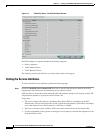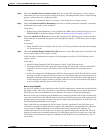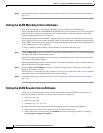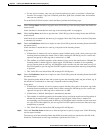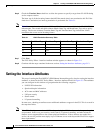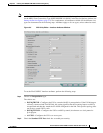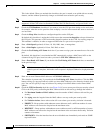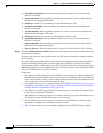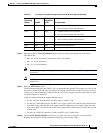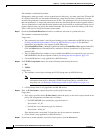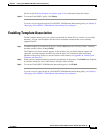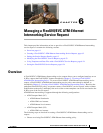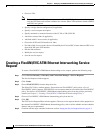
5-16
Cisco IP Solution Center L2VPN and Carrier Ethernet User Guide, 6.0
OL-21636-01
Chapter 5 Creating a FlexUNI/EVC ATM-Ethernet Interworking Policy
Setting the Interface Attributes
b. cdp shutdown threshold—Enter the number of packets per second to be received before the
interface is shut down.
c. cdp drop threshold—Enter the number of packets per second to be received at which point the
interface will start dropping CDP packets.
d. Enable vtp—Enable Layer 2 tunnelling on VLAN Trunk Protocol (VTP).
e. vtp shutdown threshold—Enter the number of packets per second to be received before the
interface is shut down.
f. vtp drop threshold—Enter the number of packets per second to be received at which point the
interface will start dropping VTP packets.
g. Enable stp—Enable Layer 2 tunnelling on Spanning Tree Protocol (STP).
h. stp shutdown threshold—Enter the number of packets per second to be received before the
interface is shut down.
i. stp drop threshold—Enter the number of packets per second to be received at which point the
interface will start dropping STP packets.
j. Recovery Interval—Enter the amount of time, in seconds, to wait before recovering a UNI port.
Step 13 Check the N-PE Pseudo-wire on SVI check box to have ISC generate forwarding commands under SVIs
(switch virtual interfaces).
By default, this check box is not checked. In this case, ISC generates forwarding commands under the
service instance.
For a FlexUNI link, the attribute N-PE Pseudo-wire on SVI is dependent on the value of the attribute
Configure with Bridge Domain (this is available in the policy workflow in the EVC Policy Editor -
Service Options window). N-PE Pseudo-wire on SVI, if enabled, will be reflected only when Configure
with Bridge Domain is set to true. Otherwise, the service request will not be created with xconnect under
SVI, even if N-PE Pseudo-wire on SVI is enabled.
Usage notes:
• ISC supports a hybrid configuration for FlexUNI/EVC service requests. In a hybrid configuration,
the forwarding commands (such as xconnect) for one side of an attachment circuit can be configured
under a service instance, and the xconnect configuration for the other side of the attachment circuit
can be configured under a switch virtual interface (SVI).
• For examples of these cases, see configlet examples FlexUNI/EVC (Pseudowire Core Connectivity,
Bridge Domain, Pseudowire on SVI), page A-39 and FlexUNI/EVC (Pseudowire Core Connectivity,
no Bridge Domain, no Pseudowire on SVI), page A-40.
• N-PE Pseudo-wire on SVI is applicable for all connectivity types, but a hybrid SVI configuration is
possible only for pseudowire connectivity.
• When MPLS Core Connectivity Type is set as LOCAL connectivity type, the N-PE Pseudo-wire on
SVI attribute is always disabled in the policy and service request.
• The N-PE Pseudo-wire on SVI attribute is not supported for IOS XR devices. All the xconnect
commands are configured on L2 subinterfaces/service instance.
• Table 5-2 shows various use cases for hybrid configuration for FlexUNI/EVC service requests.



